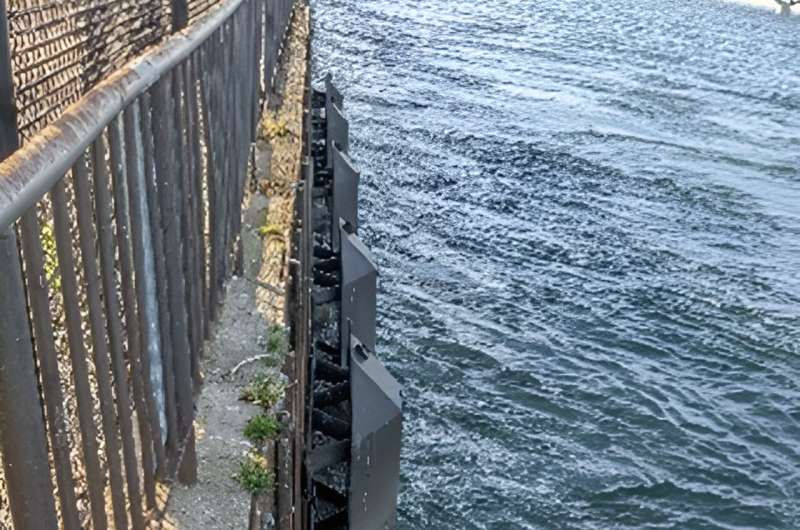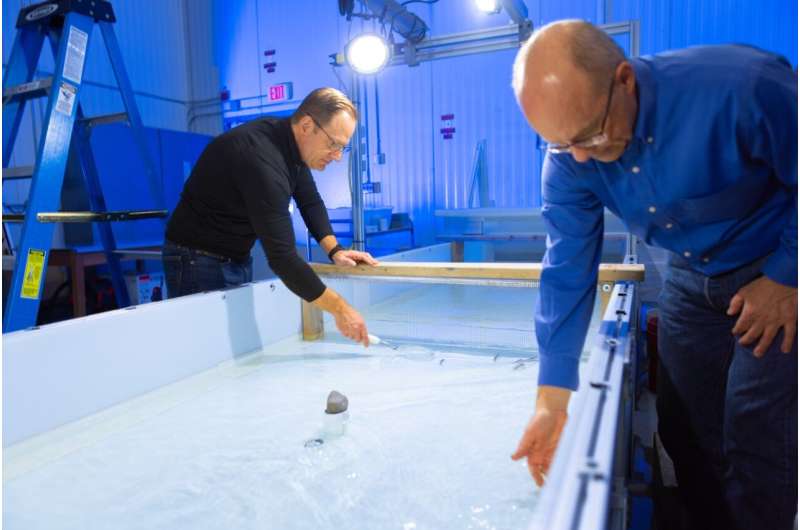This article has been reviewed according to Science X's editorial process and policies. Editors have highlighted the following attributes while ensuring the content's credibility:
fact-checked
peer-reviewed publication
trusted source
proofread
Seawall baffles and AI help emerald shiners swim to Lake Erie

University at Buffalo researchers are looking down at a 24-foot-long flume of shallow running water. Inside, about a dozen emerald shiner minnows are furiously attempting to swim against the current.
It's not going well for the shiners.
These tiny prey fish have sustained swim speeds of about 0.4 meters per second—with burst speeds up to double that—but the flume's current is running at about 0.4 meters per second, so, despite all their effort, the shiners swim to remain in place.
Yet some force starts to bring these disparate fish together. A group of two joins a group of eight, which then joins up with another group of four. Only once all 14 shiners are swimming together in tight formation do they finally begin to move upstream.
Video of this experiment will be fed into artificial intelligence tools that can track the movement of individual fish, as well as the velocity of the water.
This kind of data was the basis for the construction of an unconfined fishway along the seawall at Buffalo's Freedom Park, located near the Peace Bridge, in 2022. Ten steel, trapezoid-shaped baffles attached to the wall slow the Niagara River's velocity to allow emerald shiners to swim more easily upstream to Lake Erie, where they contribute to the health of the ecosystem including threatened birds and sport fish.
These results were described in a study published
in Ecological Engineering.
Now, the U.S. Army Corps of Engineers is preparing to place baffles on the remaining 700 feet of seawall. The $5–10 million project is currently out for bid.
In addition to helping wild emerald shiners and the rest of the Niagara River ecosystem, UB researchers' ongoing experiments with the flume and AI can shed light on fundamental aspects of all fish behavior.
"We're trying to understand what determines a fish moving from Point A to Point B. Is it responding to the flow velocity or turbulence? Or is it responding to something else?" says one of the researchers, Sean Bennett, Ph.D., professor in the UB Department of Geography and associate dean in the UB College of Arts and Sciences.
"I'm convinced that the moment that two fish see each other in the flume, their behaviors change. Rightly or wrongly, I think all fish are responding to each other."
Collecting data for fishway construction
Emerald shiners, or Notropis atherinoides, are about finger length. They're commonly used as bait.
"Despite their size, they're crucial to sustaining other wildlife in the Niagara River and Great Lakes," Bennett says.
The engineered seawall at Freedom Park had previously been identified as a barrier to the shiners' migration to Lake Erie. The depth-averaged velocities adjacent to the seawall range from 0.8 to 1.2 meters per second, much faster than emerald shiners' sustained swim speeds.
The solution seemed to be an unconfined fishway along the wall with lower velocities, but how low? And would the shiners even use it?
Bennett and his team answered these questions via their recirculating flume. Constructed by Kevin Cullinan of the College of Arts and Sciences Instrument Machine Shop, the structure can mimic real aquatic environments and has been used to study everything from soil erosion to how marine mussels engineer riverbeds.
"It would be virtually impossible to do this research in the field. Emerald shiners are extremely fragile fish, so implanting any kind of tracking device is out of the question," says Bennett, who manages the flume. "In addition, we can ensure our results are precise and reproducible, and that's what the scientific community expects from experimental research."
Another advantage of the flume is that it allowed the researchers to use AI to analyze the position of the fish in relation to the baffles and the velocity of the water. Using video taken by a mounted camera above the flume, an object detection model correctly identified fish in the frame 94% of the time. The video was also used to decipher velocity by tracking the movement of particles in the water.
"From one video image, we can determine the location of the fish and the instantaneous flow field around that fish," says Adam Grodek, a Ph.D. student in the Department of Geography and member of the research team.
Following experiments, the model found evidence that the fish in the flume generally swam upstream and toward the baffles and chose to remain near the baffles.
Relying on that data, baffles were installed at Freedom Park, previously known as Broderick Park.

Results from researchers' study show the baffles reduced the nearshore flow velocities to about 0.4 to 0.6 meters per second, within the acceptable range of velocities for the shiners. Large number of shiners were observed swimming upstream along the seawall baffles, whereas shiners away from the wall were observed being overpowered by the current and carried downstream.
Exploring the fundamentals of fish behavior
Swimming together in a school can help fish reduce friction and more easily traverse rough waters. It's not unlike a group of birds or even fighter jets moving in a V formation to improve their aerodynamics.
But how do fish know to do this?
That's one of the fundamental questions Bennett's team is now using the flume and AI to help answer.
Bennett and Grodek are collaborating with Joseph Atkinson, Ph.D., professor in the Department of Civil, Structural and Environmental Engineering, School of Engineering and Applied Sciences. Other collaborators include the Army Corps of Engineers Buffalo District and SUNY Buffalo State University.
The team is currently training an object detection model to track fish even as they move in crisscrossing patterns. Once the data are collected, an agent-based model will be built to simulate this movement.
"It's similar to studying how people would leave a movie theater if someone yelled 'fire.' You can create rules of how agents interact with other agents as a way of navigating this spatial domain," Bennett said.
There's still much that scientists don't know about how fish coordinate their movements to maintain the shape of their school. Are they reacting to other fish's movements or are they simply following the path of lower turbulence?
"We don't yet know the magnitude to which groups of fish change their behavior," Bennett says. "We're really interested in how to separate an individual fish's behavior and its transition to group behavior."
More information: Jundong Qiao et al, Unconfined fishway design, implementation, and assessment for the emerald Shiner (Notropis atherinoides) in the Upper Niagara River, New York, Ecological Engineering (2023). DOI: 10.1016/j.ecoleng.2023.107159
Journal information: Ecological Engineering
Provided by University at Buffalo





















